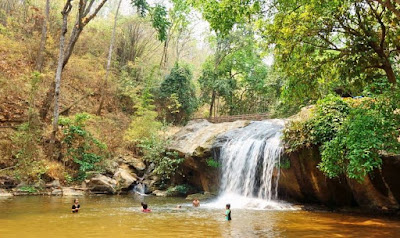The relaxation begins as soon as you see the blossoming yellow flowers lining the road leading up to the mango plantation.
Passing through a large entrance with a sign saying “Welcome to Mango Plantation Waterfall Resort”, visitors drive down a wide road that dissects rows of thousands of mango trees dominating the landscape of Battambang province’s Samlot district.
The main attraction at Chamkar Svay Waterfall Resort, as it is known in Khmer, is the river running through it, where visitors sit in gazebos eating and relaxing along its banks.
“This resort attracts people since it is not developed. They love swimming and eating on mats, as well as relaxing until dusk before they go home,” Monn Mika, 52, the resort’s owner, told The Post.
“I initially began planting mango trees without thinking about creating a resort. But with the mountainous water flow I thought it could be a tourism attraction. So I began developing it step-by-step until it started attracting many people.”
Situated next to 87ha of land that after two years is entirely cultivated with mango trees, Chamkar Svay Waterfall Resort now welcomes hundreds of visitors daily who bathe in the river that flows from Chambang Mountain.
Sok Theary, a visitor with two friends from Samlot town on a recent Sunday, praised the resorts “beautiful and cold water”.
.
.
Visitors can also order fresh food at the riverside, including roast chicken, roast fish, stir-fry or soup, as well as many appetisers and snacks, with prices ranging from 10,000 riel to 50,000 riel ($2.50 to $12.50).
Visitors are also welcome to camp in the mango plantation.
“Guests who come here do not only just swim in the natural river and explore the mango plantation, they can also go camping. We serve food and there is a cleanliness charge of $1.00 or $2.00 per person,” said Mika.
Mika said that in the dry season, the stream’s flow is lower and exposes many of the rocks on the riverbed for people to sit on. But in the rainy season, the river’s flow increases and people can enjoy bathing.
“I pay much attention to cleanliness. I tell all staff to clean the rubbish daily so it doesn’t impact visitors and keeps the environment clean.
“My current main job is to take care of the plantation and resort, so I keep making the place more attractive, and me and my wife plan to buy boats for visitors,” he said.
Chamkar Svay Waterfall Resort is located in Sambout district’s Prey Sdao village, some 80km from Battambang town or 7km from Sek Sak Tourism Resort. Visitors pay 10,000 riel to bring their car into the resort.
Source - PhnomPhenPost
.
.
















